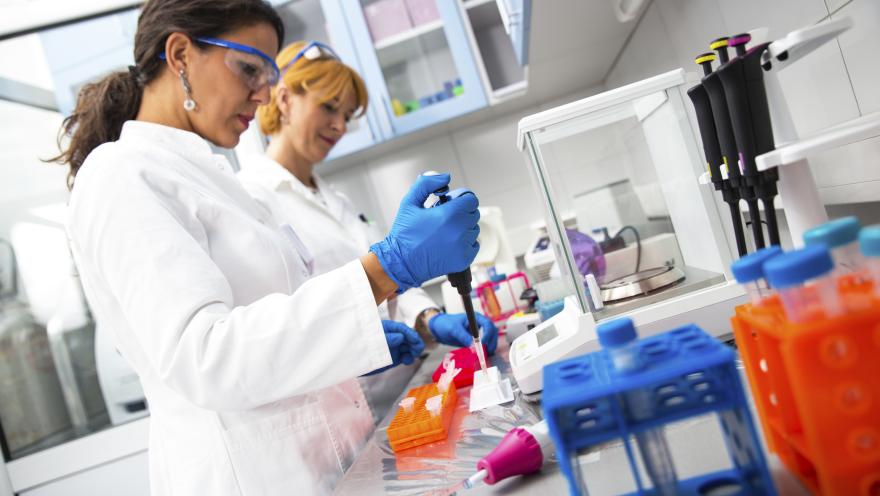The ALS Association Research Department is pleased to show their research dollars in action. Two new papers that were recently published in high impact scientific journals Proceedings of the National Academy of Sciences (PNAS) and Cell were supported by The ALS Association. The first paper by Drs. Zuoshang Xu and John Landers from the University of Massachusetts Medical School in Worcester, Mass., demonstrates a novel profilin 1 (PFN1) mouse model that displays disease characteristics similar to human disease. This paper underscores the importance of developing novel animal models to understand ALS disease processes and to discover new therapeutic targets. The second paper by Dr. J. Paul Taylor and colleagues from St. Jude Children’s Hospital in Memphis, Tenn. reveals a new disease mechanism involving the C9ORF72 expansion mutation that will be targeted for ALS therapy.
New Profilin 1 mouse model replicates multiple aspects of ALS
To date, the SOD1 mutant mouse and a series of emerging ALS animal models have replicated the major features of human ALS: degeneration of motor neurons, progressive weakness and early death. Since genetic (inherited) mutations accounts for a small percentage of all ALS cases, researchers are always trying to develop new animal models. In a new study, Yang et al. present a new model that also displays these features, as well as cellular characteristics reminiscent of the human disease. They model the mutant ALS gene profilin 1 (PFN1), which is a rare genetic cause of ALS – only two percent of people with inherited ALS have this mutation. PFN1 is an actin-binding protein, which is responsible for maintaining the shape of cells and is important for the neuron’s axon maintenance and growth. They show that mice expressing mutant PFN1 develop weakness with age and eventually become paralyzed. They also characterized the cellular characteristics of motor neurons, which showed progressive degeneration in the spinal cord. Motor neurons also developed of aggregates (clumps of protein) only after the symptoms appeared. These aggregates may interfere with the protein degradation (recycling) machinery of motor neurons.
Work remains to determine the exact cause of PFN1 induced motor neuron toxicity. Researchers plan to use this model to further uncover the cellular pathways that underlie ALS. This new model of progressive degeneration will also be compared to the SOD1 mouse model to understand the similarities and differences of the two animal models, providing clues to new targets for ALS therapies.
Paper Citation: Yang C, Danielson EW, Qiao T, Metterville J, Brown RH Jr, Landers JE, Xu Z. Mutant PFN1 causes ALS phenotypes and progressive motor neuron degeneration in mice by a gain of toxicity. Proc Natl Acad Sci U S A. 2016 Sep 28.
To read the PNAS paper click here.
New C9ORF72 disease mechanism uncovered
Expansion of the C9ORF72 mutation is the most common cause of inherited ALS and frontotemporal dementia (FTD). This mutation accounts for up to 40% of inherited ALS and FTD and ~5-10% of sporadic (no family history) ALS. Mutations of the C9ORF72 gene lead to the production of “dipeptide repeat proteins” (DPRs), which previous studies suggest are toxic to motor neurons (cells the die in ALS).
Lee et al. delve into how these DPRs are toxic to motor neurons by exploring the types of proteins they can interact with. They show that two types of DPRs, both which contain the amino acid arginine, interact with multiple proteins known to bind RNA, called RNA binding proteins. They are important for processing and reading the genetic instructions of genes – to make proteins. Specifically, they found that DPRs interact with RNA-binding proteins that often mediate the function of membrane-less organelles (parts of your cells that do not have a membrane surrounding them). Examples of membrane-less organelles include the nucleolus (responsible for manufacturing ribosomes, which help build proteins), stress granules (structures in the cell that serve as temporary storage sites for RNA when cells are under stress) and the nuclear pore complex (the gateway between the nucleus and the cytoplasm where molecules are shuttled in between) (Figure 1). Importantly, the DPR interactions perturbed the dynamics, physical properties and/or multiple functions of these membrane-less organelles, potentially causing toxicity to the cell.
This study sheds new light on how the C9ORF72 mutation causes ALS. Results point to yet another target for ALS therapy – preventing the interference of DPRs with RNA binding proteins to stop the negative impact on membrane-less organelles (Figure 2). This research also suggests there may be common pathways at work, namely the disruption of the dynamics and function of membrane-less organelles, overlapping in other forms of ALS as well. This makes these results even more important to understanding the disease as a whole.
Paper Citation: Lee KH, Zhang P, Mitrea D, Mohona S, Freibaum B, Cika J, Coughlin M, Messing J, Molliex A, Maxwell B, Kim NC, Temirov J, Moore, J, Kolaitis RM, Shaw T, Bai B, Peng J, Kriwacki R, Kim HJ, Taylor JP. C9or72 dipeptide repeats impair the assembly, dynamics, and function of membrane-less organelles. Cell 2016 Oct 20.
To read the Cell paper click here.
To read the press release click here.


Join the conversation. Please comment below.